Several years ago Anthony Caro was invited to propose a large-scale work for one of the central malls on Park Avenue in midtown Manhattan. This was in connection with Park Avenue Malls, on ongoing program begun more than ten years ago under the auspices of the Park Avenue Authority and in which a number of sculptors had already taken part. Typically, Caro had his own approach to the project: it mattered to him that in addition to passersby there were countless cars moving in both directions, and he began to think in terms of making a work long enough to lend itself to being viewed meaningfully from passing cars as well as by pedestrians. This involved building maquettes of the street, trying out various possible designs for the construction itself, visiting New York more than once to study the site in detail and pursue various questions on the ground, returning to London and modifying the models in accordance with his new findings, and so on.
Before long, Caro’s proposal envisioned a construction fully three city blocks long, represented in his Camden Town, London, studio by a model built to 1:4 scale and erected at waist height with trees and bushes made of wire and plastic. This not only allowed Caro to have a better view of the work and its setting; it also provided the structural engineer who would be in charge of actually erecting the piece on its intended site detailed information necessary for his calculations. In particular the model made possible the placement of load-bearing beams and such in places reflecting the structural realities of the subway running beneath Park Avenue. At this late stage of work, however, the project had to be abandoned owing to considerations of cost.
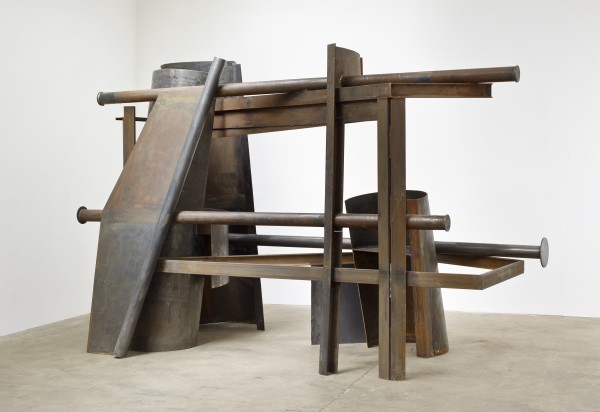

By the time this happened Caro had been engaged with the project, not exclusively but nevertheless seriously, for at least two years, and his disappointment at its abandonment should have been considerable. Perhaps it was, briefly. But almost immediately (“coming from the tea room into the studio,” he says) he recognized that the segments of the overall construction raised on their struts had the makings of sculptures in their own right, and he decided on the spot to use them as starting points for individual pieces. There followed an intense campaign of work as the larger construction was divided into sections and those sections in turn were, one by one, transformed in countless ways into large, abstract, and autonomous works of art.
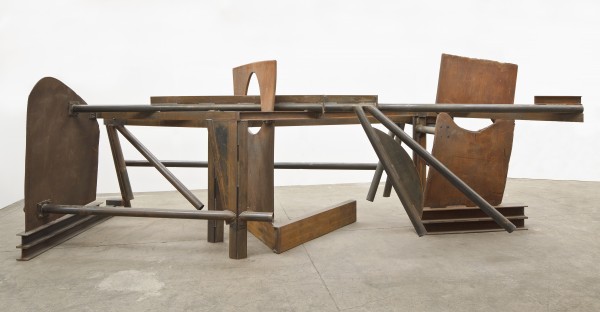
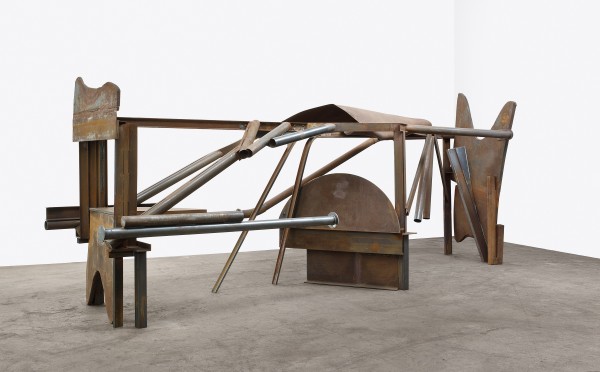
In the end there turned out to be twelve such sculptures, eleven of which are on view in the present exhibition, the twelfth, River Song, being simultaneously on display at the Museo Correr in Venice. Eventually, I am convinced, the Park Avenue series will be recognized as one of the major triumphs of Caro’s long and distinguished career, and in particular as a knockdown demonstration of the continued viability of high modernist abstraction in the face of the widespread assumption that no such thing is any longer even conceivable. In advance of that recognition a few points may usefully be made.
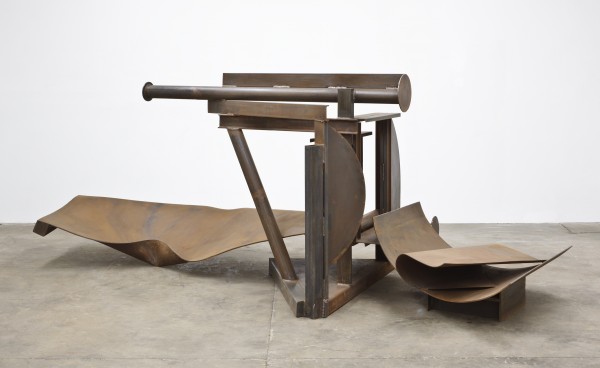
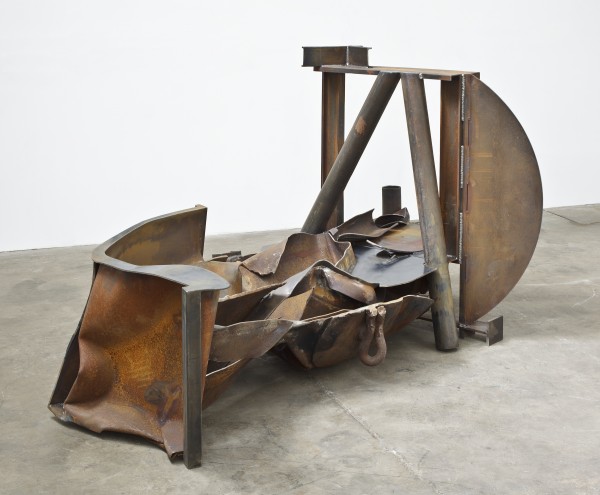
First, all the pieces (save one) carry a positive impetus from the original project by virtue of their strong lateral organization as well as, in many of them, an unmistakable sense of abstract speed or, perhaps better, drive. Again and again, lateral elements, mainly parallel to the ground though sometimes at an angle to it, in the form of long pipes (often capped at the ends), extend or run or thrust vigorously from one end of the piece to or toward the other (usually from left to right, as seen from the sculptures’ “front”). Lateralness as a mode of organization has always been good to Caro, as in the Tate’s Early One Morning (1962) and the superb Prairie (1966). Indeed, it quickly emerged as a significant difference between his work and that of his American predecessor in welded steel, David Smith, in whose sculptures, as Clement Greenberg once noted, the uprightness of the human figure continually reasserted itself. But the Park Avenue sculptures do something new with lateralness by virtue of their all but diagrammatic clarity, as if the tubes and other lateral elements are to be seen as so many vectors given material expression, material form, before our eyes. (The lone exception to the lateral norm is the last work to be completed, Tempest, which in effect brings the series to a full stop.)
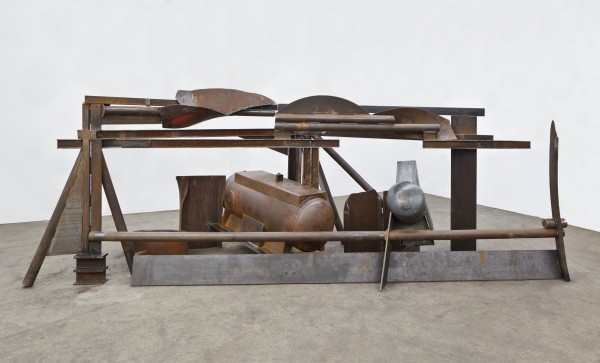
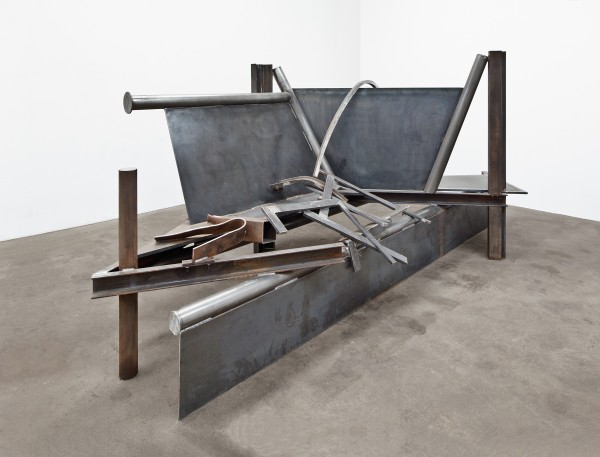
At the same time, a second point, all the sculptures make a certain show of their materiality – there is no seeming weightlessness as in the breakthrough pieces, no “opticality” as in Prairie and related works, in short no mitigation in any respect of the ontological bareness, meaning by that not just the weight but also so to speak the unwieldiness, as well as the surface qualities, of industrial steel. More precisely, all the sculptures foreground the material specificity of the miscellaneous elements that went into their making, which for the most part are of a dozen or so basic types: pipes (capped and uncapped, as I have said, also straight and curving; a new ingredient in Caro’s work), lengths of flat steel, lengths of girder, I-beam segments, frames, disks and disk segments of various sizes and thicknesses, flats of various dimensions, other flats bent convex/concave (I don’t know how else to describe them), ploughshares, heavy steel “extrusions” (the first “cuts” to have emerged from between massive rollers in the steel mill), right angles (in Horizon), boilers (in the remarkable Clouds), and in a few pieces, notably Solitude and The Brook, expanses of folded or crumpled steel. Also foregrounded, laid bare with emphasis, are the connections among these. Frequently in Caro’s earlier work elements seemed scarcely to touch one another; the relations among them, to use a term of Karen Wilkin’s, was one of “poise”; that was part of his sculpture’s originality, its distinctive syntax. But in the Park Avenue pieces all the relations are frankly physical in that the viewer apprehends exactly how the various elements have been thrust or leaned against or simply laid on top of one another, fitted together or run or slotted into each other, stacked or framed or suspended from the same or different pipes or girders, in the end not just seemingly juxtaposed but welded, bolted, and screwed together in the most direct and openly acknowledged manner imaginable. (None of this precludes a conspicuous elegance: again and again welds are intermittent, setting up an internal rhythm of their own; acute attention has been paid to joins and connections of every sort; bolts and screws have been chosen with care for their scale relative to the piece as a whole; here and there cunningly sited smaller elements appear to have a strictly esthetic justification; the very surface qualities of the different steel components seem at once to tell against and to harmonize with one another; and so on.) Compositionally, sculptures such as Morning Shadows and Wandering, two of the grandest in the group, contrast built-up units of strongly profiled components with pipes and other lateral elements running between them while also establishing different levels of activity starting on the ground. Other works proceed differently, but the fact that all the sculptures derive from the same initial project gives the series as a whole tremendous coherence at the same time as each sculpture on its own seems the product of a distinct originating inspiration – not quite a contradiction but almost. In Clouds, perhaps the most monumental piece of all, upright beams end short of the ground only to have I-beam segments inserted so as to support them from below (though the effect is rather of “extending” the sculpture downward, so to speak). Elsewhere, as in Towards Morning and Dawn of Day, elements are laid directly on the ground; this is also true, in a sense, of the dented concave steel sheet in the marvelous Solitude, which rests on the ground at its lowest point. Indeed, throughout the series the ground is given unfamiliar weight, if I may so put it. And yet this simple-seeming fact turns out to be as exhilarating in its way as the evocation of weightlessness in Midday and other sculptures of the early 1960s.

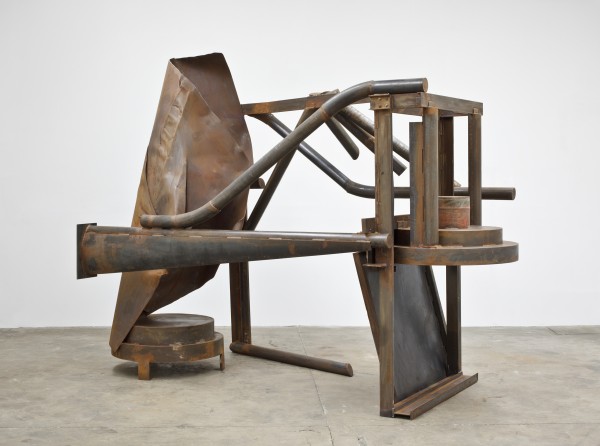
The result, point number three, is an extraordinary impression of clarity of an almost demonstrative kind even as the “imagery” of individual sculptures such as Towards Morning, River Song, and Torrents of Spring is as rich and strange as anything in Caro’s oeuvre (the last of those in particular, with its trio of rectilinear bars bending toward the ground from up high and its paired heavy oval steel “feet” that one might think would rest flat on the ground but don’t, has a positively exotic or Matissean feel). Caro’s abstract work has almost never made a secret of its manufacture, but, again, there is something uniquely compelling about the sheer lucidity both of the relationships the Park Avenue pieces comprise and of the evidence and implication of the process of making that they place before one, especially in view of their scale and complexity. For one thing, all the works are conspicuously open — as if their having been pulled apart from some larger construction has left them exposed to view in a new way. Among the aspects so revealed is, as in Horizon, Towards Morning, and Morning Shadows, the role of axes at an angle to the dominant lateral thrust of the sculpture as a whole; again, the interplay of lateralness versus angled axes is not without precedent in Caro’s work but throughout the Park Avenue series it functions as a basic organizing principle, the secondary axis or axes interpenetrating with the primary one without throwing the latter off course. (In Tempest we see different axes all but canceling each other out, which largely accounts for its “stopping” character.) Something else worth mentioning is that although all the sculptures imply a dominant, “frontal” view, they have also been made with great attention to other possible approaches, and in fact from some of those the form of a given work appears, not transformed exactly, but unexpectedly developed, even explicated. (The disposition of the sculptures in the present show allows that feature of the series to emerge with particular force.)
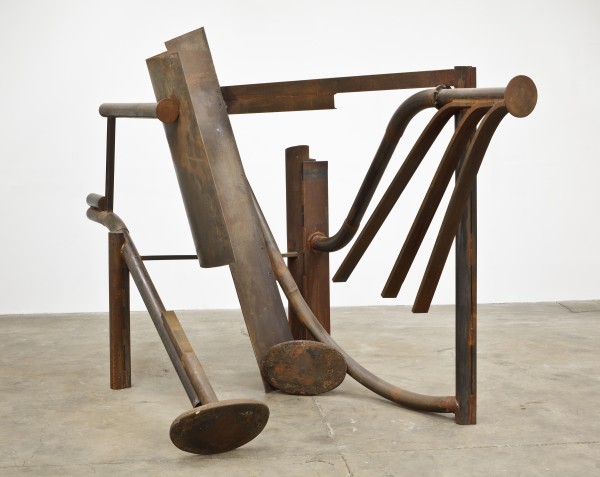

Finally, I just wrote of the overall effect of the sculptures as being as being something like intellectual clarity, but it would be no less accurate to call it musical — the individual lines of force, articulated by elements that are at once standard (pipes, girders, beams, long flats, right angles, and the like) and highly specific (this pipe, of just this length and diameter, running straight across or thrusting or indeed bent upward or downward, capped in just this way, etc.) being in effect different “voices” that one follows in their various permutations even as one also grasps the ensemble, in each sculpture in turn, as a simultaneous whole.1 The interpenetration of axes, also, might be described as musical in its very abstractness, as if it were the equivalent of a shift of key, a modulation of some sort. And behind each sculpture’s unique blend of lyricism and power, determining every esthetic choice, every cut, weld, join, addition, and inflection, every large or small, strategic or detailed, cumulatively near-heroic act of mastery of this most resistant of artistic mediums: the eighty-nine year-old perfectionist artist’s indefatigable will. This, too, has perhaps never before been acknowledged by Caro with such utter nakedness.
* * * * *
Postscript, August 2013: The above first appeared as a catalogue introduction to an exhibition of eleven of Caro’s Park Avenue sculptures at the Gagosian Gallery on Britannia Street, London (June 6-August 23, 2013). I wrote it almost exactly as it appears here before actually visiting the exhibition, on the strength of having followed the making of the sculptures in Caro’s studio over several years. (After that visit I made several slight revisions to the text.) Now that I’ve seen the finished pieces gathered together, displayed in three large rooms plus an entrance space, I want to add that the exhibition itself is beyond praise – my only regret, a huge one, is that it will come down in just a few weeks instead of staying open forever as a monument to Caro’s genius, to high modernism, to abstraction, to the sculptural medium of welded steel. Walking through those rooms I couldn’t help recalling my first encounter with Midday in Caro’s Hampstead courtyard in the fall of 1961, and the almost instantaneous conviction it inspired in me that it was the work of an artist of the highest imaginable gifts, ambition, and originality. Now just short of fifty-two years later that conviction has been validated – not for the first time — in the most overwhelming terms.
My thanks to Mark Francis and Gagosian Gallery for allowing the republication of my essay on nonsite as well as for making available the images of Caro’s sculptures accompanying it.
Notes
Several years ago Anthony Caro was invited to propose a large-scale work for one of the central malls on Park Avenue in midtown Manhattan. This was in connection with Park Avenue Malls, on ongoing program begun more than ten years ago under the auspices of the Park Avenue Authority and in which a number of sculptors had already taken part. Typically, Caro had his own approach to the project: it mattered to him that in addition to passersby there were countless cars moving in both directions, and he began to think in terms of making a work long enough to lend itself to being viewed meaningfully from passing cars as well as by pedestrians. This involved building maquettes of the street, trying out various possible designs for the construction itself, visiting New York more than once to study the site in detail and pursue various questions on the ground, returning to London and modifying the models in accordance with his new findings, and so on.
Before long, Caro’s proposal envisioned a construction fully three city blocks long, represented in his Camden Town, London, studio by a model built to 1:4 scale and erected at waist height with trees and bushes made of wire and plastic. This not only allowed Caro to have a better view of the work and its setting; it also provided the structural engineer who would be in charge of actually erecting the piece on its intended site detailed information necessary for his calculations. In particular the model made possible the placement of load-bearing beams and such in places reflecting the structural realities of the subway running beneath Park Avenue. At this late stage of work, however, the project had to be abandoned owing to considerations of cost.


By the time this happened Caro had been engaged with the project, not exclusively but nevertheless seriously, for at least two years, and his disappointment at its abandonment should have been considerable. Perhaps it was, briefly. But almost immediately (“coming from the tea room into the studio,” he says) he recognized that the segments of the overall construction raised on their struts had the makings of sculptures in their own right, and he decided on the spot to use them as starting points for individual pieces. There followed an intense campaign of work as the larger construction was divided into sections and those sections in turn were, one by one, transformed in countless ways into large, abstract, and autonomous works of art.


In the end there turned out to be twelve such sculptures, eleven of which are on view in the present exhibition, the twelfth, River Song, being simultaneously on display at the Museo Correr in Venice. Eventually, I am convinced, the Park Avenue series will be recognized as one of the major triumphs of Caro’s long and distinguished career, and in particular as a knockdown demonstration of the continued viability of high modernist abstraction in the face of the widespread assumption that no such thing is any longer even conceivable. In advance of that recognition a few points may usefully be made.


First, all the pieces (save one) carry a positive impetus from the original project by virtue of their strong lateral organization as well as, in many of them, an unmistakable sense of abstract speed or, perhaps better, drive. Again and again, lateral elements, mainly parallel to the ground though sometimes at an angle to it, in the form of long pipes (often capped at the ends), extend or run or thrust vigorously from one end of the piece to or toward the other (usually from left to right, as seen from the sculptures’ “front”). Lateralness as a mode of organization has always been good to Caro, as in the Tate’s Early One Morning (1962) and the superb Prairie (1966). Indeed, it quickly emerged as a significant difference between his work and that of his American predecessor in welded steel, David Smith, in whose sculptures, as Clement Greenberg once noted, the uprightness of the human figure continually reasserted itself. But the Park Avenue sculptures do something new with lateralness by virtue of their all but diagrammatic clarity, as if the tubes and other lateral elements are to be seen as so many vectors given material expression, material form, before our eyes. (The lone exception to the lateral norm is the last work to be completed, Tempest, which in effect brings the series to a full stop.)


At the same time, a second point, all the sculptures make a certain show of their materiality – there is no seeming weightlessness as in the breakthrough pieces, no “opticality” as in Prairie and related works, in short no mitigation in any respect of the ontological bareness, meaning by that not just the weight but also so to speak the unwieldiness, as well as the surface qualities, of industrial steel. More precisely, all the sculptures foreground the material specificity of the miscellaneous elements that went into their making, which for the most part are of a dozen or so basic types: pipes (capped and uncapped, as I have said, also straight and curving; a new ingredient in Caro’s work), lengths of flat steel, lengths of girder, I-beam segments, frames, disks and disk segments of various sizes and thicknesses, flats of various dimensions, other flats bent convex/concave (I don’t know how else to describe them), ploughshares, heavy steel “extrusions” (the first “cuts” to have emerged from between massive rollers in the steel mill), right angles (in Horizon), boilers (in the remarkable Clouds), and in a few pieces, notably Solitude and The Brook, expanses of folded or crumpled steel. Also foregrounded, laid bare with emphasis, are the connections among these. Frequently in Caro’s earlier work elements seemed scarcely to touch one another; the relations among them, to use a term of Karen Wilkin’s, was one of “poise”; that was part of his sculpture’s originality, its distinctive syntax. But in the Park Avenue pieces all the relations are frankly physical in that the viewer apprehends exactly how the various elements have been thrust or leaned against or simply laid on top of one another, fitted together or run or slotted into each other, stacked or framed or suspended from the same or different pipes or girders, in the end not just seemingly juxtaposed but welded, bolted, and screwed together in the most direct and openly acknowledged manner imaginable. (None of this precludes a conspicuous elegance: again and again welds are intermittent, setting up an internal rhythm of their own; acute attention has been paid to joins and connections of every sort; bolts and screws have been chosen with care for their scale relative to the piece as a whole; here and there cunningly sited smaller elements appear to have a strictly esthetic justification; the very surface qualities of the different steel components seem at once to tell against and to harmonize with one another; and so on.) Compositionally, sculptures such as Morning Shadows and Wandering, two of the grandest in the group, contrast built-up units of strongly profiled components with pipes and other lateral elements running between them while also establishing different levels of activity starting on the ground. Other works proceed differently, but the fact that all the sculptures derive from the same initial project gives the series as a whole tremendous coherence at the same time as each sculpture on its own seems the product of a distinct originating inspiration – not quite a contradiction but almost. In Clouds, perhaps the most monumental piece of all, upright beams end short of the ground only to have I-beam segments inserted so as to support them from below (though the effect is rather of “extending” the sculpture downward, so to speak). Elsewhere, as in Towards Morning and Dawn of Day, elements are laid directly on the ground; this is also true, in a sense, of the dented concave steel sheet in the marvelous Solitude, which rests on the ground at its lowest point. Indeed, throughout the series the ground is given unfamiliar weight, if I may so put it. And yet this simple-seeming fact turns out to be as exhilarating in its way as the evocation of weightlessness in Midday and other sculptures of the early 1960s.


The result, point number three, is an extraordinary impression of clarity of an almost demonstrative kind even as the “imagery” of individual sculptures such as Towards Morning, River Song, and Torrents of Spring is as rich and strange as anything in Caro’s oeuvre (the last of those in particular, with its trio of rectilinear bars bending toward the ground from up high and its paired heavy oval steel “feet” that one might think would rest flat on the ground but don’t, has a positively exotic or Matissean feel). Caro’s abstract work has almost never made a secret of its manufacture, but, again, there is something uniquely compelling about the sheer lucidity both of the relationships the Park Avenue pieces comprise and of the evidence and implication of the process of making that they place before one, especially in view of their scale and complexity. For one thing, all the works are conspicuously open — as if their having been pulled apart from some larger construction has left them exposed to view in a new way. Among the aspects so revealed is, as in Horizon, Towards Morning, and Morning Shadows, the role of axes at an angle to the dominant lateral thrust of the sculpture as a whole; again, the interplay of lateralness versus angled axes is not without precedent in Caro’s work but throughout the Park Avenue series it functions as a basic organizing principle, the secondary axis or axes interpenetrating with the primary one without throwing the latter off course. (In Tempest we see different axes all but canceling each other out, which largely accounts for its “stopping” character.) Something else worth mentioning is that although all the sculptures imply a dominant, “frontal” view, they have also been made with great attention to other possible approaches, and in fact from some of those the form of a given work appears, not transformed exactly, but unexpectedly developed, even explicated. (The disposition of the sculptures in the present show allows that feature of the series to emerge with particular force.)


Finally, I just wrote of the overall effect of the sculptures as being as being something like intellectual clarity, but it would be no less accurate to call it musical — the individual lines of force, articulated by elements that are at once standard (pipes, girders, beams, long flats, right angles, and the like) and highly specific (this pipe, of just this length and diameter, running straight across or thrusting or indeed bent upward or downward, capped in just this way, etc.) being in effect different “voices” that one follows in their various permutations even as one also grasps the ensemble, in each sculpture in turn, as a simultaneous whole.1 The interpenetration of axes, also, might be described as musical in its very abstractness, as if it were the equivalent of a shift of key, a modulation of some sort. And behind each sculpture’s unique blend of lyricism and power, determining every esthetic choice, every cut, weld, join, addition, and inflection, every large or small, strategic or detailed, cumulatively near-heroic act of mastery of this most resistant of artistic mediums: the eighty-nine year-old perfectionist artist’s indefatigable will. This, too, has perhaps never before been acknowledged by Caro with such utter nakedness.
* * * * *
Postscript, August 2013: The above first appeared as a catalogue introduction to an exhibition of eleven of Caro’s Park Avenue sculptures at the Gagosian Gallery on Britannia Street, London (June 6-August 23, 2013). I wrote it almost exactly as it appears here before actually visiting the exhibition, on the strength of having followed the making of the sculptures in Caro’s studio over several years. (After that visit I made several slight revisions to the text.) Now that I’ve seen the finished pieces gathered together, displayed in three large rooms plus an entrance space, I want to add that the exhibition itself is beyond praise – my only regret, a huge one, is that it will come down in just a few weeks instead of staying open forever as a monument to Caro’s genius, to high modernism, to abstraction, to the sculptural medium of welded steel. Walking through those rooms I couldn’t help recalling my first encounter with Midday in Caro’s Hampstead courtyard in the fall of 1961, and the almost instantaneous conviction it inspired in me that it was the work of an artist of the highest imaginable gifts, ambition, and originality. Now just short of fifty-two years later that conviction has been validated – not for the first time — in the most overwhelming terms.
My thanks to Mark Francis and Gagosian Gallery for allowing the republication of my essay on nonsite as well as for making available the images of Caro’s sculptures accompanying it.
Notes